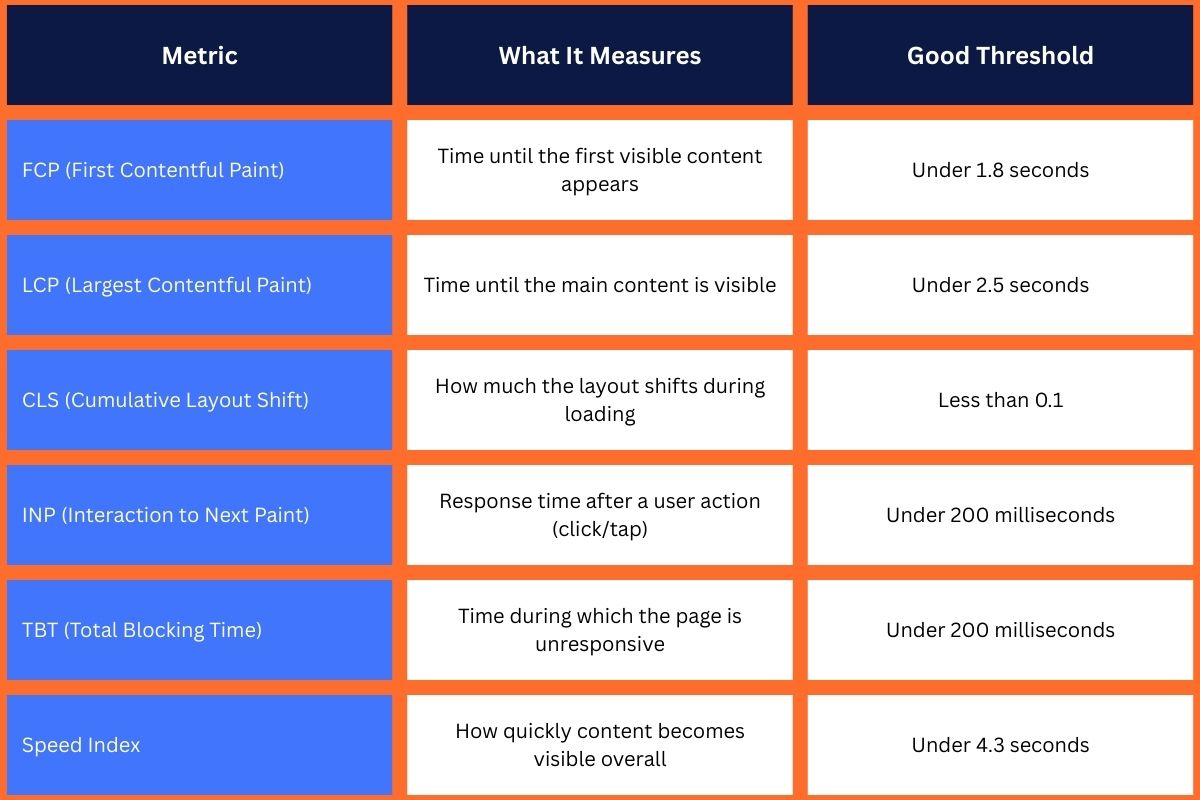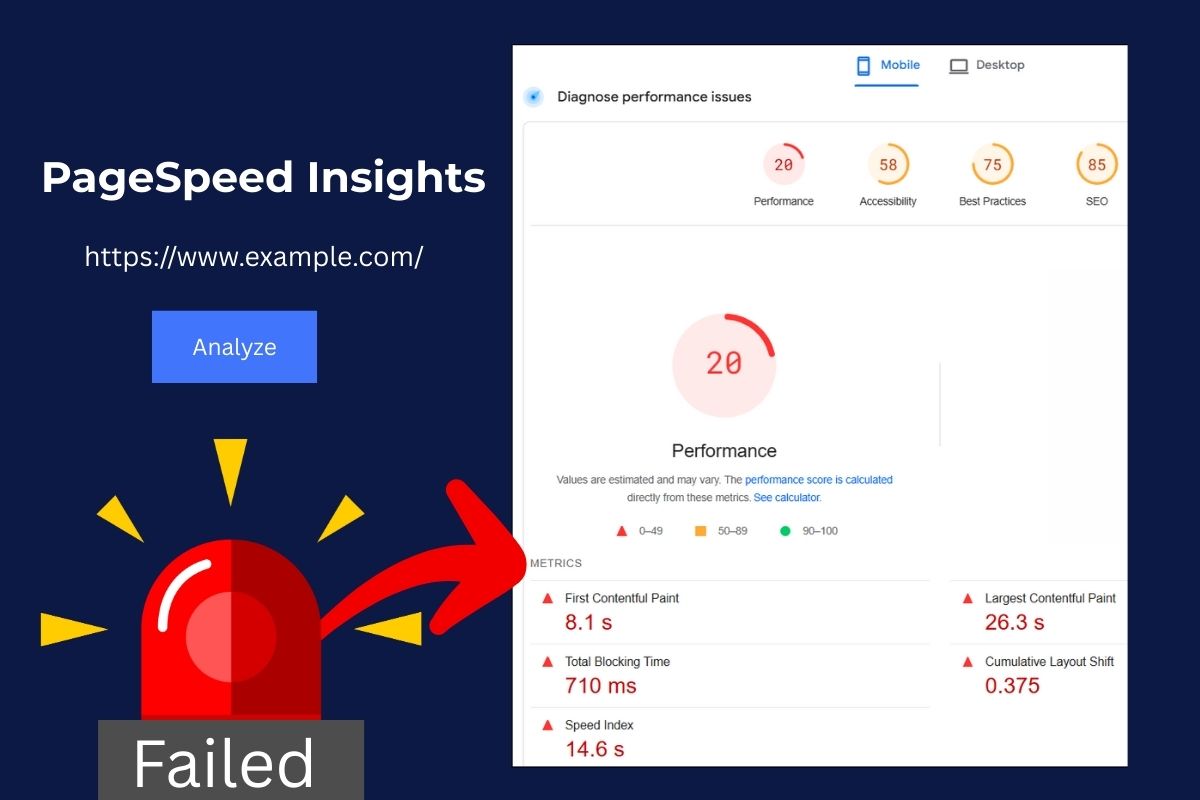The importance of page speed has changed dramatically since the internet began. While it once meant simple loading times, 2025 brings new ways to measure how users experience your website. Speed now shows how well people can use your site and if they’ll stick around.
Google’s Core Web Vitals show us what makes a website work well. These tools track real people using your site – from loading screens to clicking buttons. How important is page speed for SEO shows the fact that it has become an SEO ranking factor that can make or break your online success.
What happens when Core Web Vitals show poor performance? Your site loses visibility, frustrates visitors, and misses sales targets. Search engines now push slow, unstable websites down in their rankings.
Every millisecond counts in today’s digital landscape. Ready to learn what these vital measurements mean for your website? Let’s explore each one step by step.
PageSpeed Insights and Core Web Vitals: Understanding the Tools and Metrics
You need the right tools to make your website better. That’s why PageSpeed Insights (PSI) and Core Web Vitals work together to show you what needs fixing.
PageSpeed Insights, made by Google, looks at your webpage and gives it a score. It shows how well your site works on phones and computers. Think of PSI as your website’s doctor who finds problems and tells you how to solve them.
But there’s more to the story. Core Web Vitals have become the real measure of success. These tools track what matters to people using your site. They look at:
- Loading speed
- Interactivity
- Visual stability
So what are core web vitals metrics? Simply, they exist to show if people enjoy using your site, not just if it works well on paper.

Core web vitals and PSI together tell the full story about your site’s performance. Google uses this information to decide where your site appears in search results.
Why Core Web Vitals Matter for SEO (and Business)
Core Web Vitals affect everyone who relies on search traffic, not just tech teams. Google now includes these measurements in its ranking system, which makes the impact of page speed on SEO more obvious than ever. Sites that work well for real users tend to rank higher.
The importance of page speed in SEO shows up in many ways:
- Fast pages keep visitors reading
- Quick responses make people trust you
- Stable layouts help visitors buy more
Why is page speed important for SEO? Because in 2025, you can’t compete without it. Slow sites lose visitors, sales, and search rankings. This tells Google your site isn’t helpful – and that hurts your business.
Indexed Zone SEO research shows that technical performance, including Core Web Vitals, stands as a key part of lasting SEO success. Good content matters, but how well that content loads and works matters just as much.
What PageSpeed Insights Shows You
To speed up your site, you first need to find what is slowing it down. PageSpeed Insights (PSI) helps you do just that. It’s like a GPS that shows you the fastest route to better performance.
Lab Data: Your Testing Ground
Lab data comes from tests in controlled settings. It uses specific devices, screens, and internet speeds. When you run these tests, you get the same results each time. This helps you find and fix problems.
You might see messages about removing blocking resources or cutting down extra code. While users might not see these issues, they make your site slower. Lab data points out these hidden problems and shows how fixing them helps.
Field Data: Real People, Real Results
Field data shows how Chrome users experience your site. It captures what happens across different phones, computers, and internet connections.
Google relies on this data the most. It decides if your site passes the Core Web Vitals test. Field data changes daily based on how people use your site. This makes it valuable – it shows what really happens.
Understanding Your Score
PSI gives you a score from 0 to 100 based on lab tests. Here’s what matters: even a high score doesn’t guarantee success. You could score 90+ and still see a Core Web Vitals assessment failed message if real users have problems.
Look past the score at the actual measurements. Check your Largest Contentful Paint (LCP), Cumulative Layout Shift (CLS), and other vital signs. These affect your search rankings and users most.
Getting Speed Right
How to check page speed? Don’t stop at one test. Use PSI often and compare it with Google Search Console’s reports. This shows you both technical issues and real-world results.
Think of PSI as your early warning system. It spots problems, explains why they matter, and shows you how to fix them.
Core Web Vitals (and Related Metrics) That Matter in 2025
Want to know why Core Web Vitals matter in 2025? These metrics show how well users can use your website in real life. Let’s break down each one in simple terms.
📌 Quick note before we begin:
Google officially considers only three metrics as Core Web Vitals:
- LCP (Largest Contentful Paint)
- CLS (Cumulative Layout Shift)
- INP (Interaction to Next Paint)
These are shown in the Core Web Vitals report inside Google Search Console, using real user data.
Tools like PageSpeed Insights go a step further by showing supporting metrics like FCP, TBT, and Speed Index — these help you understand and improve the core metrics more effectively.

- First Contentful Paint (FCP)
When you open a webpage, how fast do you see anything at all? That’s what FCP measures. Your site should show its first element within 1.8 seconds. Think of opening a book – you want to see words right away, not a blank page. - Largest Contentful Paint (LCP)
LCP tracks when your main content appears. This could be your hero image or main heading. You need this to show up within 2.5 seconds. If a shopping site shows its product image quickly, it’s doing LCP right. - Cumulative Layout Shift (CLS)
Have you ever tried to click a button that jumped away? That’s what CLS measures – how much your page moves while loading. Keep your CLS score under 0.1 to stop these frustrating jumps. - Interaction to Next Paint (INP)
When users click or tap something, how fast does your site respond? INP tracks this response time. Aim to respond within 200 milliseconds – that’s faster than a blink. This new metric replaced First Input Delay to better show how your site handles user actions.- 💡 Note: INP replaced First Input Delay (FID) as the official Core Web Vital for interactivity in 2024. While FID measures the delay before a page responds to the first input, INP captures a broader picture—how consistently responsive your site feels across all user interactions.
- ⚠️ Why you might not see INP in PageSpeed Insights:
INP is based on field data, which comes from real user interactions. If your site hasn’t received enough recent traffic, or if users haven’t interacted much with it (clicks, taps, etc.), INP may not appear in your report yet. Once more interaction data is available, this metric will show up automatically.
- Total Blocking Time (TBT)
While not a Core Web Vital, TBT matters. It shows how long users must wait before they can use your page. Keep this under 200 milliseconds to avoid frustrated visitors. - Speed Index
This measures how your whole page loads over time. Your content should appear within 4.3 seconds. Think of it like a smooth video versus a choppy one – smoother is better.
What are core web vitals if not a way to improve page speed and make websites work better for real people? By watching these numbers, you can fix problems before they drive visitors away.
Interpreting Core Web Vitals Metrics
Once you understand your Core Web Vitals data, you need to know what to do with it. Think of these metrics as road signs pointing to problems, not just scores on a report.
Indicators, Not Absolutes
A perfect Core Web Vitals score doesn’t always mean users love your site. And failing one test doesn’t mean your website is broken. These numbers help you spot issues that need fixing – they don’t tell the whole story about your success.
Field vs. Lab Data
Field data shows how real people use your site in the wild. Google uses this data to decide where you show up in search results. Lab data helps you find problems before users see them. You need both, but remember – lab results don’t always match real life.
PSI Scores vs. Real UX
Getting a high PageSpeed Insights score feels good, but does it mean users enjoy your site? Not always. You need to balance technical performance with how easy your site is to use. Think about how people navigate, view your site on phones, and interact with your content.
Holistic Approach
Look at Core Web Vitals as one tool in your kit. Mix these insights with how long people stay on your site, how many buy from you, and what your SEO metrics show. Good performance helps, but it’s just one part of giving users what they want.
Mistakes to Avoid: Don’t Fall for These Traps
Want to know how to improve Core Web Vitals? First, learn what not to do. Many sites get a Core Web Vitals assessment: failed result because they make these common mistakes. Let’s look at what to avoid and what to do instead:
❌ Common Mistakes
- Obsessing over achieving a perfect 100 PageSpeed Insights score
- Only optimizing the homepage
- Ignoring how your site performs on mobile devices
- Relying solely on lab data to evaluate performance
- Fixing one Core Web Vital metric without looking at the others

✅ Better Practices
- Focus on improving real user experience instead of chasing perfect PSI scores
- Audit and optimize product pages, blog posts, and landing pages — not just your homepage
- Prioritize mobile-first design and performance optimization
- Always validate changes using field data from real users (like in Search Console)
- Treat Core Web Vitals as a connected system — monitor and improve all metrics together
Take a balanced approach instead. Remember – if you improve loading speed but break your layout stability, you still fail. Focus on steady improvements across all areas rather than perfect scores in just one.
How to Check and Improve Core Web Vitals (Using the Right Tools)
If you want to improve page speed and pass your Core Web Vitals test, you need the right tools—and you need to know how to use them. Here are six essential tools that help you measure performance, improve Core Web Vitals, and track real-world results over time.
1. PageSpeed Insights
Start at pagespeed.web.dev. This tool gives you both lab data (simulated performance) and field data (from real users). It shows if your page passes or fails Core Web Vitals and provides specific suggestions—like compressing images or deferring scripts. Watch for the “Core Web Vitals assessment: failed” message—it’s what Google uses in rankings.

2. Google Search Console → Core Web Vitals Report
In Search Console, head to the Experience > Core Web Vitals tab. You’ll see how groups of pages perform based on real user data. It highlights what’s good, what needs work, and where to focus first.
3. Lighthouse (in Chrome DevTools)
Open your site in Chrome, right-click, and choose Inspect, then go to the Lighthouse tab. Run audits for mobile or desktop. You’ll get detailed performance insights, accessibility checks, and SEO feedback.
4. Web.dev
This is Google’s educational hub for web performance. It won’t test your site directly, but it gives step-by-step tutorials on best practices for optimizing page speed and fixing Core Web Vitals issues.
5. CrUX (Chrome UX Report)
The CrUX Dashboard shows how your site performs for real users across devices and locations. It pulls from Chrome users’ actual experiences and is great for comparing trends over time.
6. Core Web Vitals API
For advanced teams, this API lets you monitor Core Web Vitals in real time, set up alerts, and build custom dashboards. Ideal for large or dynamic websites where things change often.
Each tool adds context, helping you optimize page speed across blogs, product pages, or video-heavy content—without the guesswork. Together, they support a complete strategy that follows the best practices for optimizing page speed.
How to Improve Page Speed and Core Web Vitals
Want a faster website that keeps visitors happy? Let’s look at proven ways to boost your site’s performance, whether you run a simple blog or a video-heavy platform.
A. Simple Steps That Speed Up Any Website
These fixes work for all types of pages:
- Compress images using tools like TinyPNG or ImageOptim.
- Lazy-load images so they don’t load until needed.
- Minify JavaScript and CSS to reduce file sizes.
- Defer non-critical scripts to prevent blocking the main thread.
- Use a CDN to serve content faster from nearby servers.
- Enable browser caching so returning users load faster.
- Preload key assets like fonts and hero images.
- Reduce third-party scripts like trackers or ad embeds.
These page speed optimization techniques help you meet Google’s standards more often.
B. Making Video-Heavy Pages Load Faster
Video content adds weight—literally. Here’s how to improve page load speed that have video:
- Lazy-load video players, especially those placed below the fold.
- Use static poster images instead of loading the full video on page load.
- Avoid autoplay, or only autoplay videos if they are muted.
- Compress video files or host them externally (e.g., YouTube or Vimeo).
- Reserve space for video containers to prevent layout shifts and improve CLS (Cumulative Layout Shift).
- Preload thumbnails, but delay loading the actual player code until user interaction.
C. Better Hosting Makes Faster Sites
Even with perfect front-end optimizations, a slow server can still ruin your Core Web Vitals. Here’s what to check:
- Use fast, reliable hosting. Shared hosting can bottleneck performance during traffic spikes.
- Enable server-side caching to reduce the load time for dynamic pages (especially on WordPress, Shopify, etc.).
- Use HTTP/2 or HTTP/3 protocols to allow faster, parallel loading of resources.
- Upgrade your PHP or Node version if your backend supports it—newer versions run more efficiently.
Talk to your hosting provider about performance best practices. Many platforms now include Core Web Vitals monitoring as part of their dashboards.
E. Make Speed Part of Your Routine
Performance isn’t a one-time fix. Treat it like ongoing maintenance. Here is a practical schedule:
Weekly:
- Check core metrics in PageSpeed Insights
- Look for new large images or videos added
- Monitor server response times
Monthly:
- Full site speed audit
- Compare metrics to the previous month
- Check competitor load times
- Review and remove unused plugins/scripts
Quarterly:
- Deep performance review
- Update optimization strategies
- Test on new devices and browsers
- Plan major infrastructure upgrades if needed
Small changes over time lead to a consistently fast, stable site. That’s what both users and Google want.
Final Thoughts: Performance Is UX
When we talk about Core Web Vitals, we’re talking about how real people experience your website. Speed, responsiveness, and stability aren’t just technical goals—they’re what make your site usable.
Forget chasing perfect lab scores. Aim for a site that feels smooth, fast, and reliable to your visitors. That’s the future of SEO, design, and user trust.
Test Your Own Site
Take a minute today to test your homepage and top-performing pages using PageSpeed Insights and Google Search Console.
You might be surprised by what’s slowing you down—and how a few simple changes can improve your Core Web Vitals and overall SEO performance.
FAQ: Core Web Vitals and Page Speed in 2025
Do Core Web Vitals apply to all types of websites, including e-commerce and blogs?
Yes. Whether you run a personal blog or a large online store, Core Web Vitals affect how users experience your site—and how Google ranks it. The type of content may influence which metrics matter most (e.g., INP is especially crucial for interactive pages).
Can plugins and page builders hurt my Core Web Vitals?
They can. Some add unnecessary scripts or bloated stylesheets, which slow down your site. Always audit your plugins and test after installing new tools.
How often do Core Web Vitals benchmarks change?
Google hasn’t set a fixed schedule, but benchmarks can evolve with web standards and user expectations. It’s smart to keep an eye on official updates.
Is there a way to automate Core Web Vitals monitoring?
Yes. Tools like Lighthouse CI, CrUX dashboards, and the Core Web Vitals API allow continuous performance tracking and alerts.



